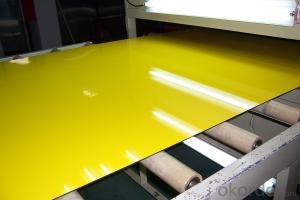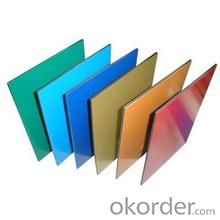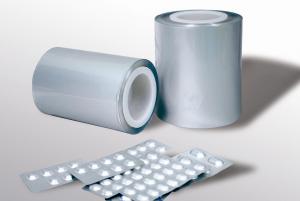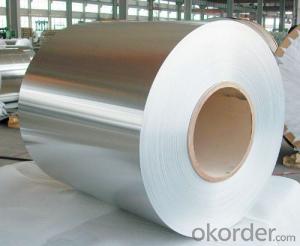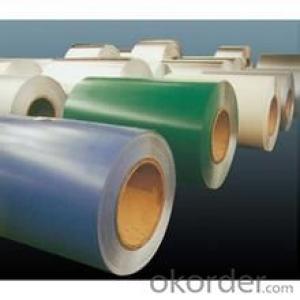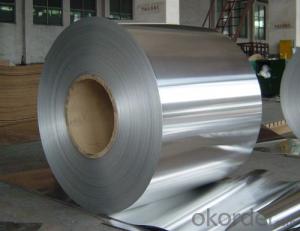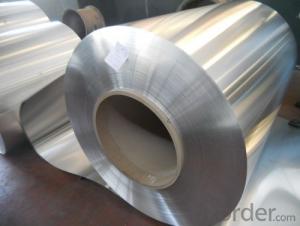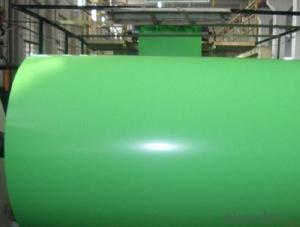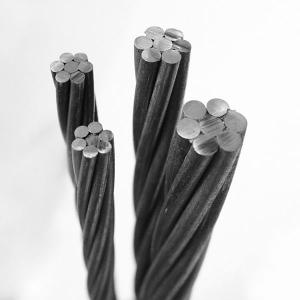EN AW - 4017 PVDF Prepainted Aluminium Composite Panel
- Loading Port:
- Shanghai
- Payment Terms:
- TT OR LC
- Min Order Qty:
- 5 m.t.
- Supply Capability:
- 1000 m.t./month
OKorder Service Pledge
OKorder Financial Service
You Might Also Like
Item specifice
1. Structure of EN AW - 4017 PVDF Prepainted Aluminium Composite Panel
EN AW - 4017 PVDF Prepainted Aluminium Composite Panel is one semi-finished aluminium material. This coil can be rolled down to aluminium coil,sheet,circle ect. The alloy AA1050 is widly used in building, industry ect. Its weight is much lower than steel. So many customers choosed aluminium material instead of steel.
2. Specification of EN AW - 4017 PVDF Prepainted Aluminium Composite Panel
EN AW - 4017 PVDF Prepainted Aluminium Composite Panel | |
Main Specification | |
Alloy | AA1xxx (AA1050, AA1060, AA1070, AA1100 etc.) |
AA3xxx (AA3003, AA3004, AA3005, AA3105 etc.) | |
AA5xxx, AA6XXX (AA5052,AA5083, AA5754, AA6061, AA6062 etc.) | |
AA8xxx(AA8011, AA8006 etc.) | |
Temper | H14,H16, H18, H22, H24, H26, H32,O/F, T4, T6, T651 |
Thickmess | 0.01mm-100mm |
Width | 30mm-1700mm |
Standard | GB/T 3880-2006/ASTM |
Special specification is available on customer's requirement | |
3. Application of EN AW - 4017 PVDF Prepainted Aluminium Composite Panel
(1).Interior: wall cladding, ceilings, bathrooms, kitchens and balconies, shutters, doors...
(2).Exterior: wall cladding, facades, roofing, canopies, tunnels,column covers , renovations...
(3).Advertisement: display platforms, signboards, fascia, shop fronts...
4. Feature of EN AW - 4017 PVDF Prepainted Aluminium Composite Panel
Surfact Quality :
Be free from Oil Stain, Dent, Inclusion, Scratches, Stain, Oxide Dicoloration, Breaks, Corrosion, Roll Marks, Dirt Streaks and other defect which will interfere with use,
Mechenical Property:
Chemical Composite and Mechanical Property
5. Certificate of EN AW - 4017 PVDF Prepainted Aluminium Composite Panel
SGS and ROHS(if client request, paid by client), MTC(plant provided), Certificate of Origin(FORM A, FORM E, CO), Bureau Veritas and SGS (if client request, paid by client), CIQS certificate
6. Image of EN AW - 4017 PVDF Prepainted Aluminium Composite Panel
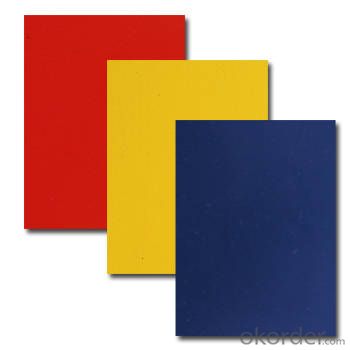
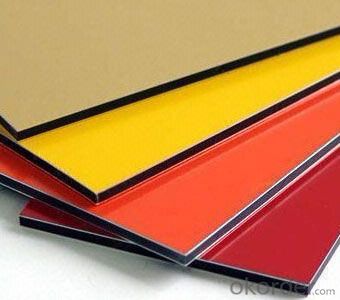
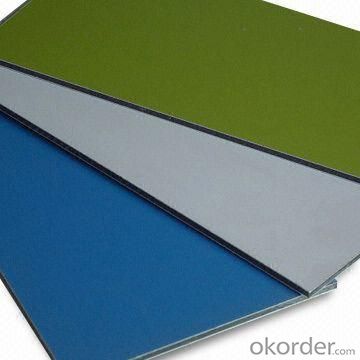
7. Package and shipping of EN AW - 4017 PVDF Prepainted Aluminium Composite Panel
First, plastic cloth with drying agent inside; Second, Pearl Wool ; Third, wooden cases with dry agent , fumigation wooden pallets, aluminum surface could cover blue PVC film
8. FAQ
1) What is the delivery time?
Depends on actual order, around 20 to 35 days
2) What is the QC system:
We have QC staff of 20 persons and advanced equipment, each production is with MTC traced from Aluminum ingot lot.
3) What market do you mainly sell to?
Australia, America, Asia, Middle East, Western Europe, Africa etc
- Q:Dongying power plant with 0.6mm thick insulation aluminum coil, manufacturers can be divided into small volumes?
- Yes, 50 meters per roll. I have a manufacturer's telephone number
- Q:How are aluminum coils inspected for quality control?
- To maintain quality control, aluminum coils undergo a thorough examination employing visual inspections and various non-destructive testing methods. These measures guarantee that the coils conform to the necessary specifications and are devoid of any flaws or defects. In order to identify surface defects, including scratches, dents, and irregularities in shape or size, trained personnel meticulously scrutinize the coils. Additionally, inspectors check for signs of contamination, oxidation, or discoloration. If any abnormalities are detected during this visual inspection, they are promptly noted and addressed. Apart from visual inspections, internal quality evaluation of the aluminum coils is conducted through non-destructive testing techniques. One commonly employed method is ultrasonic testing, which involves transmitting high-frequency sound waves through the coils. The reflected sound waves are then analyzed to detect internal defects such as voids, cracks, or delaminations. This technique allows for a comprehensive assessment of the coil's integrity without causing any harm to the material. Another non-destructive testing method used for quality control is eddy current testing. This technique induces electrical currents in the coils and measures the resulting magnetic fields. Any variations in the magnetic fields can indicate flaws or defects in the aluminum, such as cracks or inclusions. Eddy current testing is particularly effective in identifying surface defects and discontinuities. Furthermore, measurements of crucial physical properties such as thickness, width, and flatness are taken to ensure compliance with the required standards. Specialized instruments like micrometers, calipers, or laser scanners are typically employed for this purpose. In conclusion, the inspection process for aluminum coils encompasses a combination of visual inspections and non-destructive testing methods. This comprehensive approach guarantees that the coils are fault-free, meet the necessary specifications, and exhibit superior quality.
- Q:A cube of solid aluminum has a volume of 1.00 m3 at 20°C. What temperature change is required to produce a 130 cm3 increase in the volume of the cube?
- The linear expansivity of aluminum is 23 x10^-6 /K. Bulk expansivity is 3 x 23 x10^-6 / k For 130 [cm^3] the temperature required is 130 [cm] ^3/ 3 x 23 x10^-6 = 0.00013/[3 x 23 x10^-6] = 1.88 K ========================= If each side of the cube of side 1m expands by e, then its new volume = [1+e]^3 = 1 + 3e + 3e^2 +e^3. Neglecting high powers of e as negligible, the increase in volume is 3e. But e = 23 x10^-6 x rise in temperature 3e = 3*23 x10^-6 x rise in temperature. Given 3e = 0.00013 0.00013= 3*23 x10^-6 x rise in temperature Rise in temperature = 0.00013 / 3*23 x10^-6 = 1.88 K
- Q:What are the storage life and shelf life of aluminum coils?
- The storage life and shelf life of aluminum coils can vary depending on various factors such as the type of alloy, coating, and storage conditions. However, in general, properly stored and maintained aluminum coils can have a storage life of several years and a shelf life of up to 12 months or more. It is important to store them in a dry, clean, and well-ventilated area to minimize the risk of corrosion or other damage. Regular inspection and maintenance are also crucial to ensure their longevity.
- Q:What are the different surface treatments available for aluminum coils?
- Aluminum coils offer a range of surface treatments, each with its own advantages and applications. The options include: 1. Mill Finish: This is the untreated standard surface of aluminum coils. It has a dull appearance and is suitable for industrial or structural uses where aesthetics are not a priority. 2. Anodizing: Anodizing is an electrochemical process that forms a protective oxide layer on the surface of aluminum coils. This treatment improves corrosion resistance, durability, and appearance. Anodized coils are often used in architectural applications like building exteriors and window frames. 3. Paint Coating: Various paints can be applied to aluminum coils to enhance their appearance, protect against corrosion, and provide additional functionality like heat reflection or insulation. Different thicknesses and finishes are available, catering to general use or specific industries like automotive or aerospace. 4. Brushed Finish: This treatment involves brushing abrasive materials onto the surface of aluminum coils to create a textured finish. Brushed coils have distinct patterns and are commonly used in decorative applications, interior design, or signage. 5. Embossed Finish: Aluminum coils can be embossed with patterns or textures to enhance their appearance or functionality. This process alters the surface, creating raised or recessed designs. Embossed coils find applications in architecture, automotive, and packaging. 6. Laminating: Aluminum coils can be laminated with various materials like films or foils for added protection, insulation, or decorative effects. The type of lamination material used determines the appearance, durability, or functionality enhancements. These examples highlight the available surface treatments for aluminum coils. The choice depends on specific requirements such as aesthetics, corrosion resistance, durability, or functionality. Selecting the appropriate treatment ensures the desired performance and longevity of the coils in their intended use.
- Q:To put aluminum heads on my car do i have to add other things or basically can i just get them and put them on
- Aluminum heads will warp the first time the engine accidentally overheats. Why would you go with aluminum?
- Q:How are aluminum coils different from other types of metal coils?
- There are several ways in which aluminum coils differ from other types of metal coils. Firstly, aluminum is a lightweight metal, resulting in much lighter coils compared to those made from steel or copper. This lightweight nature of aluminum makes it highly sought after in industries where weight is a crucial consideration, such as aerospace and automotive industries. Secondly, aluminum coils have exceptional resistance to corrosion. Unlike other metals, aluminum forms a protective oxide layer on its surface when exposed to air, effectively preventing further corrosion. This corrosion resistance makes aluminum coils ideal for use in environments that are humid and prone to corrosion, such as marine or coastal areas. Moreover, aluminum coils boast high thermal conductivity. This means that aluminum can efficiently transfer heat, making it an excellent choice for heat transfer applications like HVAC systems, refrigeration units, and radiators. The high thermal conductivity of aluminum coils enables more efficient cooling or heating processes. Additionally, aluminum is highly malleable and ductile. This means it can be easily shaped and formed without compromising its structural integrity. The malleability of aluminum coils allows for flexibility and versatility, enabling them to be manufactured into various shapes and sizes to meet specific industry requirements. Lastly, aluminum is an environmentally sustainable and recyclable material. It can be recycled repeatedly without any degradation in quality or performance, making aluminum coils an environmentally friendly option. This recyclability aspect helps reduce the environmental impact and supports a circular economy. In conclusion, aluminum coils stand out from other metal coils due to their lightweight nature, corrosion resistance, high thermal conductivity, malleability, and recyclability. These unique properties make aluminum coils a preferred choice for a wide range of applications across different industries.
- Q:How do aluminum coils contribute to sustainable packaging?
- Sustainable packaging practices are greatly influenced by aluminum coils. Firstly, aluminum possesses the unique quality of being infinitely recyclable, meaning it can undergo recycling processes repeatedly without compromising its properties or quality. This aspect significantly enhances the sustainability of packaging as it reduces the necessity of extracting and processing new materials, thereby conserving natural resources and minimizing the environmental impact associated with mining and production. Furthermore, aluminum coils boast exceptional barrier properties, effectively safeguarding packaged goods from external elements including moisture, light, and oxygen. This barrier function plays a crucial role in prolonging the shelf life of products, thereby reducing food waste and eliminating the need for additional packaging or preservatives. By maintaining the freshness of products for extended periods, aluminum coils contribute to sustainable packaging efforts by combating food loss and promoting resource efficiency. Moreover, aluminum's lightweight nature makes it an ideal material for packaging. Its low weight allows for reduced transportation costs and energy consumption during shipping, ultimately leading to a decrease in overall carbon emissions. Additionally, the lightweight characteristic of aluminum coils makes them convenient for end consumers, thereby minimizing the environmental impact associated with disposal and recycling. Additionally, aluminum demonstrates high durability and resistance to corrosion, ensuring the integrity of packaging throughout its lifecycle. This durability allows for the reuse or repurposing of aluminum coils, further reducing waste and extending the material's lifespan. In conclusion, the utilization of aluminum coils in packaging promotes sustainability in various ways. It contributes to a circular economy by being infinitely recyclable, reduces food waste through effective barrier properties, lowers carbon emissions through lightweight design, and encourages reuse and repurposing due to its durability. By incorporating aluminum coils into packaging solutions, significant strides can be made towards achieving a more sustainable and environmentally friendly packaging industry.
- Q:Are aluminum coils suitable for electrical conductivity applications?
- Yes, aluminum coils are suitable for electrical conductivity applications. Aluminum is a good conductor of electricity, second only to copper in terms of conductivity. It is widely used in various electrical applications, including power transmission lines, electrical wiring, and electronic devices. Aluminum coils offer efficient electrical conductivity while being lightweight, cost-effective, and resistant to corrosion.
- Q:Can aluminum coils be used for electrical connectors?
- Certainly! Electrical connectors can indeed utilize aluminum coils. This metal, widely employed for electrical connectors, boasts exceptional electrical conductivity, a relatively affordable price, and lightweight characteristics. It finds extensive application in diverse electrical domains such as power transmission, distribution systems, electrical motors, and transformers. Nonetheless, it is crucial to prioritize adequate insulation and protection for the aluminum coils to avert corrosion and guarantee enduring dependability for the electrical connections.
1. Manufacturer Overview |
|
|---|---|
| Location | |
| Year Established | |
| Annual Output Value | |
| Main Markets | |
| Company Certifications | |
2. Manufacturer Certificates |
|
|---|---|
| a) Certification Name | |
| Range | |
| Reference | |
| Validity Period | |
3. Manufacturer Capability |
|
|---|---|
| a)Trade Capacity | |
| Nearest Port | |
| Export Percentage | |
| No.of Employees in Trade Department | |
| Language Spoken: | |
| b)Factory Information | |
| Factory Size: | |
| No. of Production Lines | |
| Contract Manufacturing | |
| Product Price Range | |
Send your message to us
EN AW - 4017 PVDF Prepainted Aluminium Composite Panel
- Loading Port:
- Shanghai
- Payment Terms:
- TT OR LC
- Min Order Qty:
- 5 m.t.
- Supply Capability:
- 1000 m.t./month
OKorder Service Pledge
OKorder Financial Service
Similar products
New products
Hot products
Hot Searches
Related keywords
